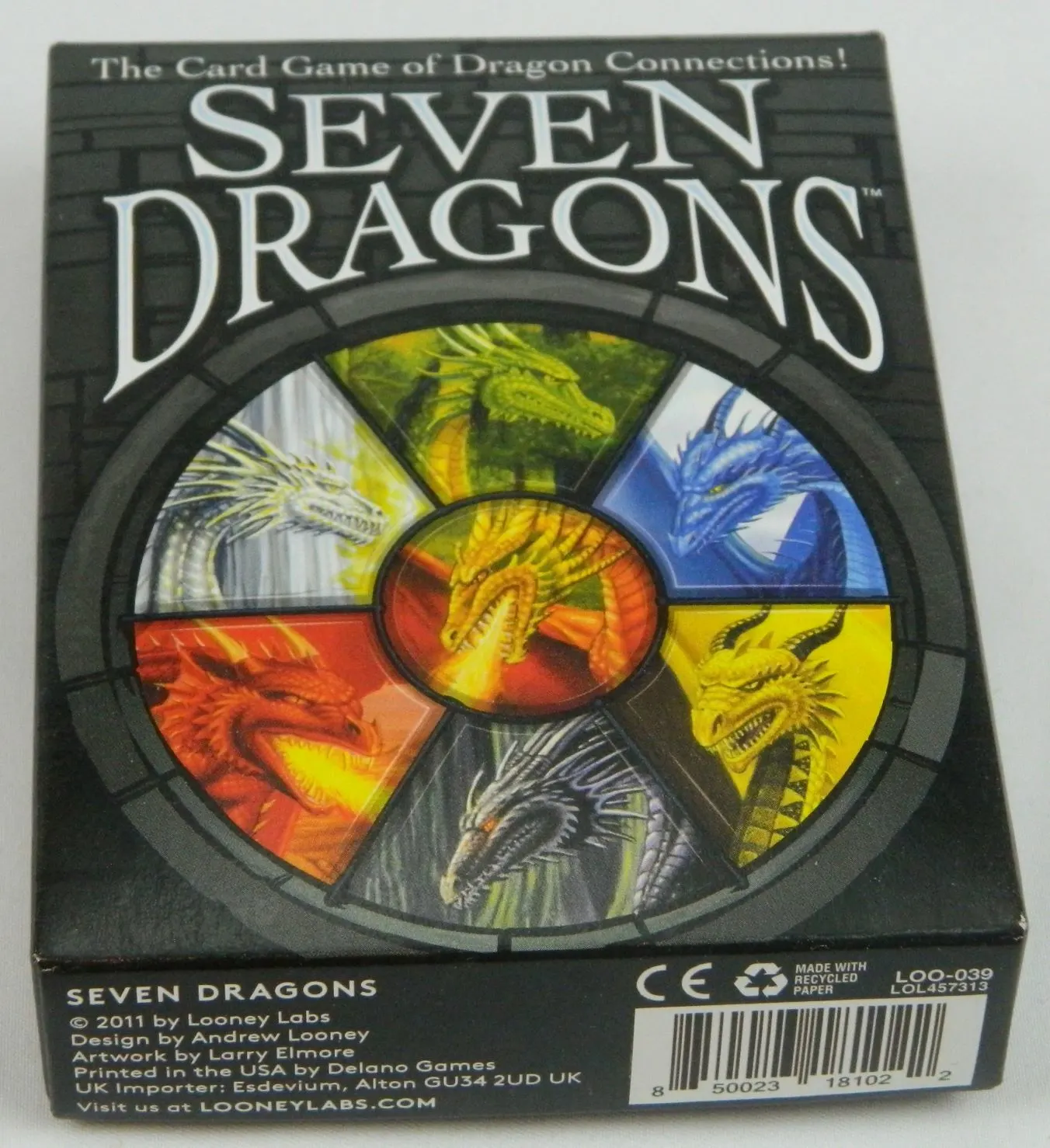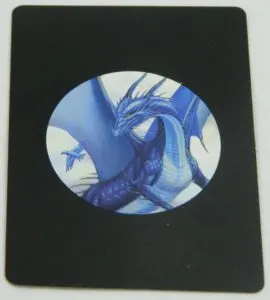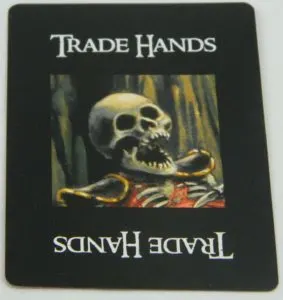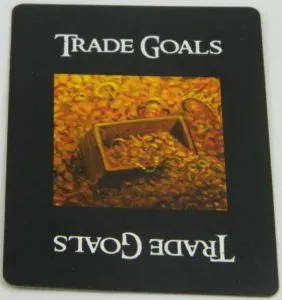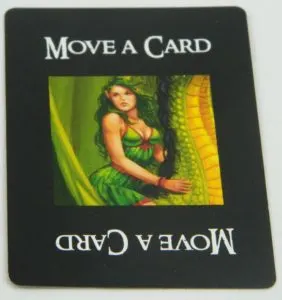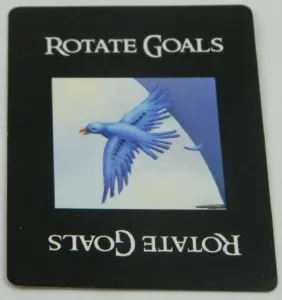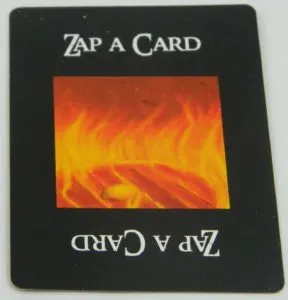Looney Labs, probably most known for the Fluxx franchise, is celebrating its 25th year in business by bringing back some of its games from the past that have not been in print for a number of years. Two of these are Martian Fluxx and Oz Fluxx. The third game is Seven Dragons which I am taking a look at today. Seven Dragons was originally released back in 2011 and is based off of an older game called Aquarius from 1998. While Looney Labs mostly makes Fluxx games, I am always intrigued to try out some of their other games as well. Some people may find Seven Dragons to be a little chaotic, but for those that can get past that fact there is a really fun twist on your typical Dominoes game.
How to Play Seven Dragons
Setup
- Shuffle the five goal cards and deal one to each player. Any goal cards not dealt to players should be placed face down in a line between two players as if they were held by imaginary players. Each player can look at their goal card, but they shouldn’t show it to the other players.
- Place the silver dragon card in the center of the table. This card will remain in the same position for the entire game.
- Shuffle the rest of the cards and deal three cards face down to each player. The rest of the cards will form the draw pile.
- The oldest player will start the game.
Playing the Game
You will begin your turn by drawing the top card from the draw pile and adding it to your hand.
You will then play one of the cards from your hand. Depending on what type of card that you play, you will take different actions.
Dragon Cards
For the first dragon card any card can be played next to the silver dragon as it is wild to begin the game.
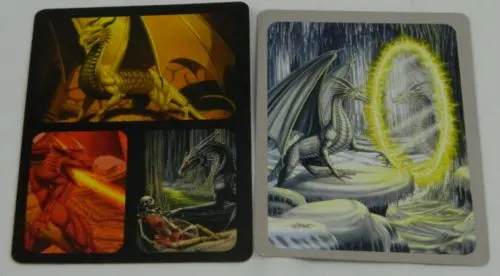
For the first card a player played this card featuring a yellow, red, and black dragon next to the silver dragon.
When a player plays a dragon card they will place it next to at least one of the cards already placed out on the table. For a new card to be played at least one of the panels has to match a dragon of the same color on a neighboring card.
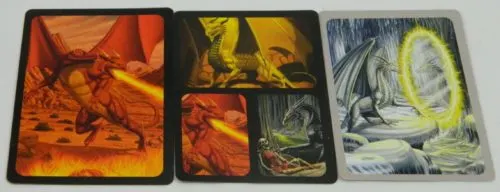
For the second card the player played the red dragon card. As it matched the red dragon in the bottom left corner of the card next to it, the card was legally played.
If the new card does not have a panel touch another panel of the same color, the card cannot be played.
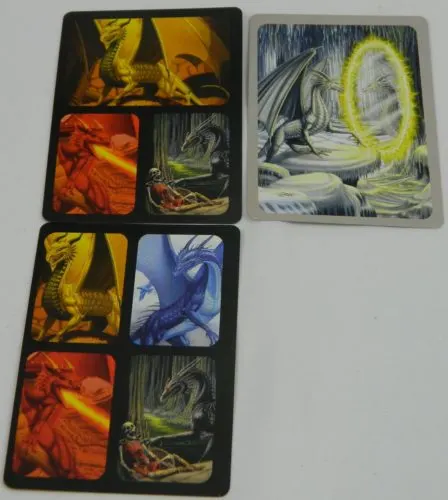
The current player tried to play the bottom card. As it doesn’t match any of the colors from the card above it, it cannot be played.
When placing cards all of the cards must be played in the same orientation (some cards can’t be played up and down and others side to side). All cards must be placed directly next to a card and not offset.
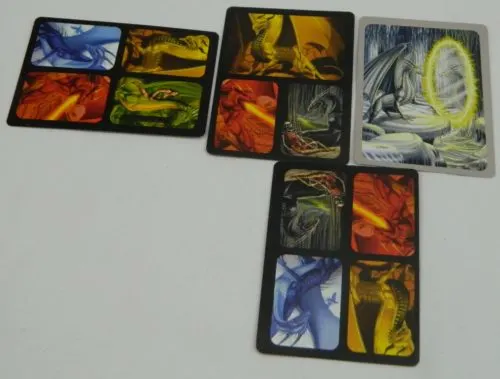
Pictured are two cards played incorrectly. The card on the left is wrong as it is turned in the opposite direction of the other cards. The card on the bottom is wrong because it wasn’t played flush against another card.
There are two exceptions to the color rule. First the rainbow dragon is wild and will act as every color.
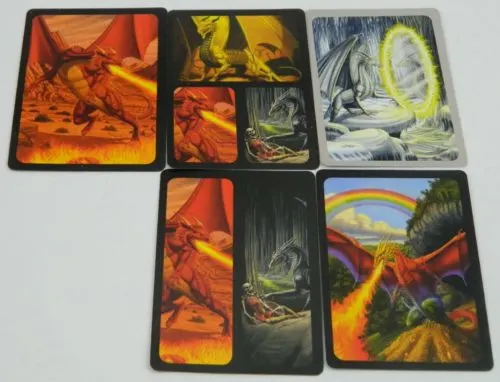
The current player played the rainbow dragon in the bottom right corner. It was allowed as it will match both the black dragon and whatever color the silver dragon is currently as it matches every color.
The silver dragon is the start card and will change colors throughout the game. The silver dragon’s color corresponds to the color of the dragon on the top of the discard pile. To begin the game the silver dragon acts like the rainbow dragon.
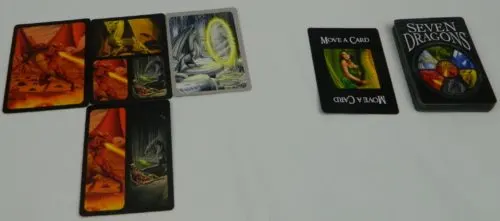
The top card of the discard pile features the green dragon. This will change the silver dragon’s current color to green
When playing a card if a player connects two or more different colors of dragons, they will get to draw bonus cards. The rainbow and silver dragons don’t count when determining whether you get bonus cards.
- 2 dragon colors – 1 bonus card
- 3 dragon colors – 2 bonus cards
- 4 dragon colors – 3 bonus cards
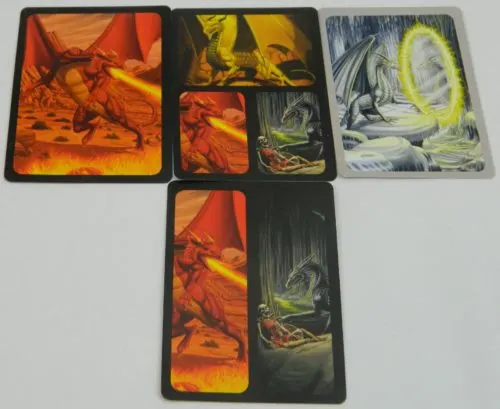
The current player played the card in the bottom row. As it matched both a red and black dragon, the player will get to draw a bonus card.
Action Cards
An Action card is played for its action and then it is discarded. Normally the card is added to the top of the discard pile. Thus the play of an Action card will give a player an action and will change the color of the silver dragon.
A player can choose to ignore one of the two impacts of their action card though. If the player doesn’t want to change the color of the silver dragon, they can add the card they played to the bottom of the discard pile. Otherwise the player can choose to play their Action card to the top of the discard pile (changing the silver dragon’s color), but ignore the card’s action.
Trade Hands
The player who plays the card chooses another player. The two players will swap all of the cards in their hands (not including their Goal cards).
Trade Goals
The player who plays the card chooses another player to trade with. The two players will swap their Goal cards. If there aren’t five players, a player can choose to trade their Goal card with one of the “imaginary” players.
Move A Card
This card allows the player who plays it to take one of the dragon cards played to the table and move it to a new legal position.
Rotate Goals
All of the players will pass their Goal card to one of their neighbors. The player who plays the card chooses the direction that the cards will be passed. When there are less than five players, the “imaginary” player(s) cards will be rotated just like if they were an actual player.
Zap A Card
When a player plays this card they will choose one of the dragon cards from the table (can’t choose the silver dragon) and adds it to their hand.
Winning the Game
When there are seven dragons connected to one another (not counting diagonals), the game will likely end. Whoever has the Goal card featuring that colored dragon will win the game.
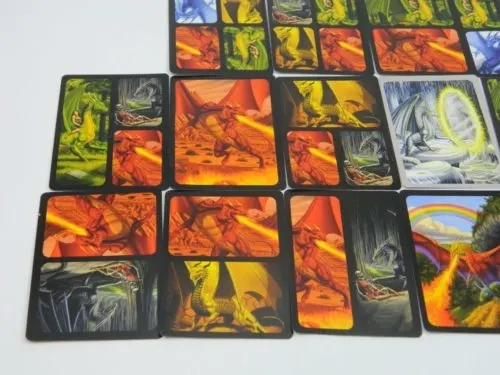
There are seven red dragons connected to one another. Whoever has the red dragon Goal card will win the game.
My Thoughts on Seven Dragons
I didn’t really know what to think of Seven Dragons before I played it. I genuinely like the games made by Looney Labs, but I didn’t really know how the publisher’s generally chaotic gameplay would mix with a Dominoes game. While the games are quite different, Seven Dragons also shares more in common with the Fluxx franchise than I originally anticipated. In a way I would say that Seven Dragons feels like what you would get if you combined Fluxx with Dominoes. I see this as a positive for some players, and a detriment to others.
While it doesn’t play exactly the same as Dominoes, there are pretty clear similarities between the two games. In the game each of the players will be given a secret goal which correlates to one of five colors. The players will take turns playing cards that are somewhat shaped like dominoes to the table. These cards can feature one, two or four different colors of dragons. In order to play a card you have to match at least one of the colors from the card you play with the cards that you played it next to. To win the game you need to get seven dragons of your secret color connected to one another.
Honestly I wouldn’t consider myself to be a big fan of Dominoes. The concept is interesting, but I always found the gameplay to be kind of dull. I personally preferred Seven Dragons over a more traditional Dominoes game. This mostly had to deal with the variety of cards present in the game. Instead of just having a tile with a number on both ends, the cards can either feature one color, two colors, or four colors. These can be broken up into a bunch of different combinations. I liked this because it just gives players more options. There is variety in how you play the cards from your hand. This adds more strategy to the game than your typical Dominoes game in my opinion. The game isn’t jam packed with strategy, but there is enough where it feels like you have an impact over your fate.
One mechanic in particular I found interesting were the bonus cards. Basically if you can play a card that matches two or more different colors, you get to draw extra cards. Having more cards in your hand is always helpful as it gives you more options on each turn. A card that you play might not help move you closer to your goal, but you may choose to play it just to earn the bonus card for the future. This is beneficial since you will keep the extra card for the rest of the game unless someone uses a card to swap hands (not a huge fan of this). This adds some strategy to the game as you might make a move just to increase your hand size.
Another thing that I liked about Seven Dragons was the addition of secret goals. Instead of just trying to get rid of all of your cards, you are trying to build towards a final goal. While it usually becomes a little obvious at some point what color everyone has, you can never know for sure. You can’t be too obvious with the cards you play to tip off the other players, but you also can’t play too many cards to help out the other players. You always need to be aware of what colors are close to reaching seven so you can prevent another player from winning. These mechanics add some deception and bluffing to the game as you try to build towards winning yourself, without alerting the other players.
I just generally enjoyed the main gameplay of Seven Dragons. The gameplay is not overly deep as it mostly gets right to the point. Anyone familiar with the main Dominoes mechanic should be able to pick up the game almost immediately. The game has a recommended age of 6+ which seems about right. The game is really straightforward as it basically boils down to drawing and playing a card. Despite the game being quite straightforward, it still has enough strategy to keep things interesting. Finding a good placement for one of your cards is just really satisfying. Unless you really don’t like the Dominoes mechanic, I think you will really enjoy this aspect of the game.
There is one element of the game that I haven’t talked about yet, and it likely will be the aspect that is the most controversial. This mechanic is the Action cards. These cards add a lot of the Fluxx-like elements to the game. Basically the Action cards add more randomness and chaos to the game. Instead of just adding a new card to those already played, players can play an Action card to sometimes drastically change the game. Some of these cards allow players to alter the placement of cards on the table, while others have players exchange cards. I think most players are going to have pretty strong feelings about these cards. I personally am somewhere in the middle as there are some things that I liked about them, and others that I had some issues with.
Lets start with the positives. First I liked the addition of the cards that allow you to remove or move cards that have been played. These cards are pretty important to the gameplay as it wouldn’t be quite the same without them. If these cards weren’t included you would mostly just have to hope that the other players don’t notice you making a group of seven dragons. These cards add quite a bit of strategy to the game as you can change things pretty quickly if you utilize them well. It is satisfying when you can find a clever way of manipulating the cards in order to win the game or get yourself much closer to winning.
The action cards also add a decent amount of suspense to the game. Early in the game no one can win as there aren’t enough cards in play where someone can even get seven in a row. Once you hit the midpoint though, you never know for sure what is going to happen. The play of one card can drastically change up the gameplay. You can easily go from a top position to the bottom, or vice versa. This keeps the game interesting as you are never out of the game until someone wins. People who like the ever changing aspect of Fluxx will likely enjoy this part of the game.
This holds true for those that don’t care for Fluxx as well though. The Action cards can make the game quite chaotic at times. You could have a great strategy all lined up, and with the play of one card it could be ruined. This ends up adding a lot of luck to Seven Dragons. There is strategy to the game as smart use of your cards can definitely improve your position in the game. Luck still plays a pretty big role though. If you don’t draw the right cards, there isn’t much you can do to help yourself. Another player can also really mess with your strategy based on what cards they choose to play. In a way it feels like the other players’ choices play as big of if not a larger role than your own cards. Basically if you aren’t a big fan of games that rely on quite a bit of luck, I don’t know if Seven Dragons will be the game for you.
As for Seven Dragons’ components, they are pretty much what you would normally expect from a Looney Labs game. The game includes 72 cards. The card quality is pretty good and is comparable to other Looney Labs games. The box size is the standard size for the publisher. As for the artwork I generally liked it. The style is actually quite a bit different than a lot of Looney Labs games. The artwork was done by Larry Elmore and looks really nice. The only real complaint that I had with the artwork was the Action cards. They are just kind of bland looking, and they should have featured the corresponding dragon instead of just a section of the relevant color card. At times it is kind of hard to tell what color a card relates to when determining the color of the silver dragon. Otherwise I really didn’t have any complaints with the components.
Should You Buy Seven Dragons?
I found Seven Dragons to be an interesting little card game. The Dominoes inspiration is pretty apparent as the game feels a lot like a twist on the traditional game. I personally preferred it over Dominoes due to the design of the cards giving players a lot more options. The game isn’t stuffed full of strategy, but you need to put thought into what cards you play and where you play them. Making a good play in the game is just really satisfying. When you add in the secret goals the Dominoes aspect of the game is quite enjoyable. As for the Action cards I was a little more conflicted. Some of the cards add a decent amount of strategy to the game. Most just add more chaos to the game though. This keeps the game interesting, but it kind of sucks when you are close to winning and another player just steals all of your hard work out from beneath you. The game can also rely on quite a bit of luck at times.
My recommendation for Seven Dragons comes down to if you think the idea of taking Dominoes and adding some twists and chaos sounds like an interesting idea. If you don’t really care for Dominoes or don’t like the chaos/randomness of games like Fluxx, I don’t see the game being for you. Those that want an interesting twist on Dominoes though and don’t mind a little randomness should really enjoy Seven Dragons and should consider picking it up.
Buy Seven Dragons online: Amazon. Any purchases made through this link (including other products) help keep Geeky Hobbies running. Thank you for your support.
We would like to thank Looney Labs for the review copy of Seven Dragons used for this review. Other than receiving the review copy we at Geeky Hobbies received no other compensation. Receiving the review copy had no impact on the content of this review or the final score.

